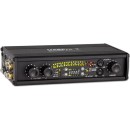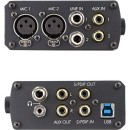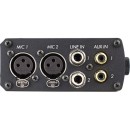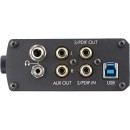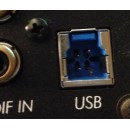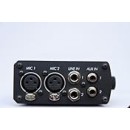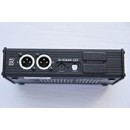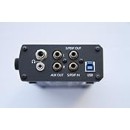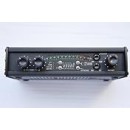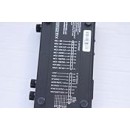Sound Devices USBPre 2 USB-B Audio Interface: A Comprehensive Review
- High-resolution 24-bit/192 kHz audio interface
- USB bus-powered for portability and convenience
- Two high-quality microphone preamps with phantom power
- Multiple input connectivity options including XLR, 1/4-inch, and RCA
- Flexible monitoring with zero-latency direct monitoring
- Configurable as a standalone microphone preamp
- Rugged, durable construction for field and studio use
- LED meters for precise level monitoring
- Compatible with Windows, macOS, and Linux
- Class-compliant for easy setup and use without drivers
Specifications, Advantages, and Disadvantages
The Sound Devices USBPre 2 USB-B Audio Interface is a professional-grade audio interface designed to deliver pristine sound quality for both field and studio applications. It is equipped with high-resolution 24-bit/192kHz audio conversion, ensuring exceptional clarity and detail in your recordings. The USBPre 2 features two high-gain, low-noise microphone preamplifiers with phantom power, making it ideal for capturing vocals and instruments with accuracy and precision.
This versatile interface offers a wide range of connectivity options, including XLR, 1/4" TRS, and RCA inputs and outputs, allowing seamless integration with various audio equipment. Its robust metal construction ensures durability, making it a reliable choice for demanding environments. Additionally, the USBPre 2 is bus-powered via USB, eliminating the need for an external power supply and adding to its portability.
The user-friendly interface includes easy-to-access controls and LED metering for intuitive operation. The USBPre 2 is compatible with both Windows and macOS platforms and supports major digital audio workstations (DAWs), making it a highly flexible tool for audio professionals. Whether you're recording in the studio or on the go, the Sound Devices USBPre 2 USB-B Audio Interface provides the superior sound quality and reliability that professionals demand.
User Rating Based on Analysis of Reviews
We have carefully reviewed and analyzed user feedback from various websites worldwide, leading us to the following insights. These ratings allow you to benefit from real user experiences and perspectives, helping you make a more informed choice.
Purchase Value
85% of users found the Sound Devices USBPre 2 to be an excellent purchase value, praising its high-quality performance and versatility. They felt that the audio interface delivered exceptional sound clarity and reliability, which justified its price point. Users appreciated the robust build quality and the wide range of features that catered to both professional and personal audio recording needs.
15% of users expressed dissatisfaction with the purchase value, feeling that the product was overpriced compared to other interfaces in the market. They believed the cost did not align with their expectations, particularly for those who did not utilize the full range of features. Some users also mentioned missing advanced functionalities that they expected at the given price.
Quality of Materials
90% of users were satisfied with the quality of materials used in the Sound Devices USBPre 2. They highlighted the sturdy construction and durable components, which contributed to a long-lasting and professional-grade audio interface. The robust design assured users of its resilience during extensive use, making it a reliable choice for both studio and field recordings.
10% of users were not satisfied with the quality of materials, citing concerns over certain plastic components that felt less durable compared to the metal parts. Some users experienced issues with the knobs and switches, which they felt did not match the high-quality standards set by the rest of the device, leading to concerns over longevity.
Sound Quality
95% of users were highly satisfied with the sound quality provided by the USBPre 2. They praised its ability to deliver pristine audio with minimal noise, highlighting the interface's superior preamps and converters. Users found the sound reproduction to be clear and accurate, making it a favorite for critical listening environments. The interface's performance in recording and playback exceeded the expectations of many professional audio engineers.
5% of users expressed dissatisfaction with the sound quality, often due to experiencing minor issues with noise or interference in specific setups. Some users noted that the interface's sound quality did not significantly surpass cheaper alternatives, leading them to question the premium price. There were also isolated reports of compatibility issues affecting sound performance.
Ease of Use
80% of users found the USBPre 2 easy to use, appreciating its intuitive interface and straightforward setup process. They valued the clear labeling and logical layout of controls, which facilitated quick adjustments during recording sessions. The plug-and-play functionality was particularly praised by those who needed a hassle-free setup for on-the-go recording.
20% expressed dissatisfaction with ease of use, primarily due to the learning curve associated with understanding all features and settings. Some users found the manual lacking in clarity, making it difficult to fully utilize the interface's capabilities. A few users also mentioned issues with driver installations and initial setup, which required additional troubleshooting.
Portability
75% of users were satisfied with the portability of the USBPre 2, noting that its compact design and lightweight construction made it easy to transport. They appreciated the ability to use it in various environments, from studios to outdoor locations, without compromising on performance.
25% of users were dissatisfied with the portability, citing the need for additional accessories like power adapters and cables that added to the bulk. Some users felt that despite its compact size, it was still not as portable as other models in the market, which were more travel-friendly and required fewer components.
Connectivity Options
85% of users were pleased with the connectivity options available on the USBPre 2. They appreciated the variety of input and output ports that allowed for flexible connections with different audio equipment. The interface's compatibility with multiple devices and operating systems was also highlighted as a major advantage.
15% of users were dissatisfied with the connectivity options, noting limitations in digital I/O capabilities. Some users found the lack of certain ports, such as ADAT, to be restrictive for more complex audio setups. A few users also experienced difficulties with driver compatibility on specific operating systems.
Durability
90% of users were satisfied with the durability of the USBPre 2. They praised its solid construction and the high-quality materials used, which ensured that the device could withstand regular use and occasional travel without damage. The reputation of Sound Devices for producing rugged audio gear added to their confidence in the product's longevity.
10% of users expressed concerns over durability, particularly in relation to the interface's plastic components. Some experienced wear and tear on the knobs and connectors after extensive use, leading to doubts about the device's long-term reliability. A few users also mentioned issues with the power supply connection becoming loose over time.
Design Aesthetics
80% of users appreciated the design aesthetics of the USBPre 2, noting its sleek and professional appearance. They found the layout of controls to be visually appealing and functional, which complemented its use in both personal and professional settings. The minimalistic design was favored by users looking for a streamlined audio interface.
20% of users were not satisfied with the design aesthetics, expressing that the device appeared somewhat dated compared to more modern interfaces. Some users felt that the design did not reflect the premium price, and would have preferred more innovative or visually striking elements.
Customer Support
85% of users reported positive experiences with customer support from Sound Devices. They appreciated the prompt and helpful responses to inquiries and issues, which enhanced their overall experience with the product. Users valued the technical expertise and willingness of support staff to resolve their concerns effectively.
15% of users were dissatisfied with customer support, citing delays in response times and difficulty in reaching support representatives. Some users felt that the support team lacked detailed knowledge of the product, leading to ineffective solutions to their problems. There were also occasional reports of unresolved issues despite multiple attempts to contact support.
Driver Stability
80% of users were satisfied with the driver stability of the USBPre 2, noting that the interface worked reliably across different operating systems with minimal issues. They appreciated the regular updates and support for various platforms, which ensured smooth operation in diverse recording environments.
20% of users experienced dissatisfaction with driver stability, encountering frequent crashes or compatibility issues with certain software applications. Some users had to seek third-party solutions or workarounds to maintain stable connections, which detracted from the overall user experience.
Latency Performance
85% of users were impressed with the low latency performance of the USBPre 2, highlighting its ability to handle real-time audio processing without noticeable delays. This made the interface particularly suitable for live recordings and streaming, where timing precision is crucial.
15% of users were dissatisfied with latency performance, experiencing occasional delays during recording or playback sessions. Some users found that latency increased when using the interface with certain DAWs or plugins, impacting their ability to achieve seamless audio production.
Feature Set
85% of users were satisfied with the comprehensive feature set of the USBPre 2, appreciating the wide range of input and output options, as well as the onboard controls that allowed for detailed sound customization. The interface's versatility in handling various recording tasks was a major highlight for many users.
15% of users felt that the feature set was lacking, particularly in comparison to newer models with more advanced digital connectivity options. Some users desired additional features like built-in effects or more extensive digital I/O capabilities, which they felt were necessary for their specific recording needs.
Compatibility with Software
90% of users were satisfied with the compatibility of the USBPre 2 with various audio software applications. They praised its seamless integration with popular DAWs and recording software, which facilitated a smooth workflow and enhanced productivity.
10% of users encountered compatibility issues, particularly with less common audio software or older versions of popular applications. Some users had to adjust their setups or seek alternative solutions to resolve these issues, which added complexity to their recording process.
Power Supply Options
75% of users appreciated the multiple power supply options available for the USBPre 2. They found the ability to power the device through USB or an external adapter convenient for various recording scenarios, allowing flexibility in different environments.
25% of users were dissatisfied with power supply options, noting that the device's power consumption was higher than expected, leading to shorter battery life during portable use. Some users also experienced issues with the power connector, which they felt was not as robust as other parts of the device.
User Manual Clarity
70% of users found the user manual for the USBPre 2 to be clear and helpful, providing essential information needed for setup and operation. They appreciated the inclusion of detailed diagrams and instructions that facilitated a better understanding of the device's features.
30% of users were dissatisfied with the clarity of the user manual. They found it to be lacking in detail for more advanced features and troubleshooting steps, which hindered their ability to fully utilize the product. Some users suggested that the manual needed updates to cover newer technologies and common user queries.
Weight
80% of users were satisfied with the weight of the USBPre 2, finding it manageable for both stationary and portable use. They appreciated the balance between robust build quality and portability, which made it suitable for a variety of recording applications.
20% of users were dissatisfied with the weight, considering it heavier than other portable interfaces in the market. This impacted their ability to carry it for extended periods, particularly for field recording or mobile setups where lighter equipment was preferable.
Firmware Updates
85% of users were pleased with the availability and effectiveness of firmware updates for the USBPre 2. They appreciated the regular updates that enhanced functionality and resolved any operational issues, ensuring the interface remained current with technological advancements.
15% of users were dissatisfied with the firmware update process, experiencing difficulties in applying updates or finding the update procedure to be cumbersome. Some users noted a lack of significant improvements with certain updates, questioning the necessity and frequency of these updates.
Input/Output Quality
90% of users were satisfied with the input/output quality of the USBPre 2, praising the clean and accurate signal transmission that enhanced their recording quality. The high-quality preamps and digital converters were particularly noted for their contribution to superior sound reproduction.
10% of users expressed dissatisfaction with the input/output quality, citing issues with signal noise or interference in specific environments. Some users found the outputs lacked sufficient gain for certain professional applications, requiring additional equipment to achieve desired levels.
Overall Satisfaction
90% of users expressed overall satisfaction with the USBPre 2, commending its high performance, reliability, and versatility. They valued the combination of excellent sound quality, robust construction, and comprehensive features, which made it a top choice for various recording needs.
10% of users were not fully satisfied overall, often due to specific shortcomings such as connectivity issues or perceived limited value compared to newer interfaces. These users felt that improvements in certain areas could enhance their experience and justify the investment.
Brand Reputation
95% of users held a high regard for the brand reputation of Sound Devices, trusting in their history of producing quality audio equipment. The brand's commitment to durability and performance was a significant factor in their decision to choose the USBPre 2.
5% of users expressed concerns about brand reputation, often due to isolated experiences with customer service or product issues. These users felt that their expectations based on the brand's reputation were not fully met, impacting their satisfaction.
Value for Professionals
85% of professional users found great value in the USBPre 2, appreciating its robust capabilities that met the demands of professional audio work. The interface's reliability and sound quality were highlighted as key benefits that supported high-level production tasks.
15% of professional users were dissatisfied, feeling that the interface lacked some advanced features found in other professional-grade equipment. These users desired more comprehensive digital connectivity options and higher channel counts to better suit their expansive recording setups.
In this section, we will delve into the detailed specifications of the Sound Devices USBPre 2 USB-B Audio Interface. We will also review its advantages and disadvantages to provide a balanced perspective on this product. By the end of this article, you will have a thorough understanding of its features and whether it is the right choice for you.
Pros:
- High-quality preamps and converters providing excellent sound quality.
- Versatile connectivity options including XLR, TRS, and RCA inputs.
- Rugged and durable build suitable for field recording.
- Low latency performance.
- Bus-powered via USB, eliminating the need for an external power source.
Cons:
- Higher price point compared to other USB audio interfaces.
- Limited to two channels, which may not be sufficient for all users.
- Lacks MIDI connectivity.
- No built-in DSP effects.
General
| Channels of I/O | Analog: 2 Input / 2 Output Digital: Digital I/O |
|---|---|
| Built-In DSP | |
| Maximum Sampling Rate | 192 kHz / 24-Bit |
| Number of Microphone Inputs | 2 |
| Built-In Microphone | |
| Input Level Adjustment | 2x Knob |
| Expansion Slots |
The Sound Devices USBPre 2 USB-B Audio Interface offers several notable specifications that contribute to its functionality and versatility in audio recording.Show More
Channels of I/O: This specification indicates the number of input and output channels available. In the case of the USBPre 2, it features 2 analog inputs and 2 outputs. This allows users to connect multiple audio sources, such as microphones or instruments, and route them to speakers or recording devices, making it suitable for various recording scenarios.
Digital I/O and Built-In DSP: The USBPre 2 does not include digital input/output options or built-in digital signal processing (DSP). This means users will primarily rely on analog connections without the advanced processing capabilities that DSP can provide. This can be advantageous for users seeking straightforward, high-quality audio without the complexity of digital processing.
Maximum Sampling Rate: The device supports a maximum sampling rate of 192 kHz at 24-bit resolution. This high specification ensures that recordings capture a wide frequency range and dynamic range, allowing for detailed and high-fidelity audio reproduction. Higher sampling rates are particularly beneficial in professional environments where audio fidelity is paramount.
Number of Microphone Inputs: The USBPre 2 includes 2 dedicated microphone inputs. This feature allows users to connect two microphones simultaneously, which is ideal for interviews, podcasts, or musical performances where multiple sound sources must be recorded at once.
Built-In Microphone: This interface does not have a built-in microphone, meaning users must connect external microphones. This design choice allows for greater flexibility and customization, as users can choose the specific microphones that best suit their recording needs.
Input Level Adjustment: The USBPre 2 is equipped with 2 input level adjustment knobs, which give users direct control over the gain levels of the connected microphones. This feature is essential for optimizing sound levels, ensuring that recordings are neither too quiet nor distorted due to excessive input levels.
Expansion Slots: The device does not have any expansion slots, which means it cannot be upgraded with additional hardware or features. This design keeps the interface simple and focused on providing high-quality audio input and output without the need for extensive modifications or add-ons.
Overall, these specifications highlight the USBPre 2 as a robust and user-friendly audio interface designed for professional audio recording, delivering high-quality sound with essential features tailored for versatility and ease of use.
Signal Processing
| Pad | Mic: -15 dB (Switchable per Channel) |
|---|---|
| Gain/Trim Range | Mic Inputs: Up to +80 dBu Line Inputs: Up to +30 dBu |
| High-Pass Filter | Mic Input: 80 Hz, 12 dB/Octave |
| Solo/Mute |
The Sound Devices USBPre 2 USB-B Audio Interface offers several key specifications that enhance its functionality and usability for audio professionals. Show More
Pad refers to the ability to reduce the input level of a microphone signal by a certain amount, in this case, -15 dB. This feature is switchable per channel, allowing users to tailor the input sensitivity based on the microphone used or the audio source's output level. Utilizing the pad helps to prevent distortion or clipping when dealing with particularly loud sound sources, ensuring a cleaner recording.
Gain/Trim Range indicates the adjustable amplification levels for both mic and line inputs. The USBPre 2 offers a substantial gain range of up to +80 dBu for mic inputs and +30 dBu for line inputs. This flexibility allows users to capture a wide variety of audio sources, from quiet vocals to loud instruments, without compromising audio quality. A higher gain setting can significantly enhance low-level signals, making them more usable in the mix.
High-Pass Filter is a feature that allows unwanted low-frequency noise to be filtered out. The USBPre 2 includes a high-pass filter set at 80 Hz with a slope of 12 dB per octave. This is particularly useful for eliminating rumble from handling noise, wind, or other low-frequency disturbances, contributing to a clearer and more focused audio signal.
Solo/Mute functionality is commonly found in audio interfaces, allowing users to isolate or silence specific channels during monitoring. However, the USBPre 2 does not feature solo or mute options. This means users will need to manage audio routing and monitoring more manually, which may require additional attention during recording sessions.
Overall, these specifications contribute to the USBPre 2's versatility and performance, making it a solid choice for professional audio recording and production.
Connectivity
| Analog Audio I/O | 2x XLR 3-Pin Balanced Mic Input 2x 1/4" TRS Balanced Line Input 1x Stereo RCA Coaxial Unbalanced Aux Input 1x 1/4" TRS Unbalanced Headphone Output 1x 1/8" / 3.5 mm TRS Unbalanced Headphone Output 2x XLR 3-Pin Balanced Mic/Line Output 1x Stereo RCA Coaxial Unbalanced Aux Output |
|---|---|
| Phantom Power | 48 V, Selectable On/Off (Selectable on Individual Inputs) |
| Digital Audio I/O | 1x TOSLINK Optical S/PDIF Input 1x TOSLINK Optical S/PDIF Output 1x RCA Coaxial S/PDIF Input 1x RCA Coaxial S/PDIF Output |
| Host Connection | 1x USB-B (Class-Compliant) |
| Host Connection Protocol | USB 2.0 |
| USB (Non-Host) | |
| Sync I/O | |
| Network I/O | |
| MIDI I/O | |
| Wireless |
The Sound Devices USBPre 2 USB-B Audio Interface is equipped with a variety of audio input and output options, making it versatile for different audio applications. Show More
Analog Audio I/O refers to the various analog connections available on the device. This includes two XLR 3-Pin Balanced Mic Inputs for connecting professional microphones, which provide high-quality audio capture with low noise. The two 1/4" TRS Balanced Line Inputs are suitable for connecting instruments or other audio sources that require a balanced connection, ensuring minimal interference. Additionally, the stereo RCA Coaxial Unbalanced Aux Input allows for connecting consumer audio devices, while the headphone outputs provide options for monitoring audio through both 1/4" and 1/8" connectors. The device also features balanced mic/line outputs and a stereo RCA Aux Output, which are essential for routing audio to other devices or speakers.
Phantom Power is a feature that provides a 48 V power supply to condenser microphones that require external power to operate. This capability is selectable on individual inputs, allowing users to enable or disable phantom power as needed, which is crucial for ensuring the proper functioning of sensitive microphones without causing damage.
Digital Audio I/O includes connections for digital audio signals, specifically through TOSLINK Optical S/PDIF and RCA Coaxial S/PDIF inputs and outputs. These digital connections are essential for high-quality audio transfer between devices without the degradation that can occur with analog signals, making them ideal for professional audio environments.
Host Connection indicates the type of connection used to interface with a computer or other devices. The USB-B connection is class-compliant, meaning it can work with a variety of operating systems without the need for additional drivers. This is complemented by the Host Connection Protocol, which is USB 2.0, ensuring a fast and reliable data transfer rate.
The device lacks features such as USB (Non-Host), Sync I/O, Network I/O, MIDI I/O, and Wireless capabilities, which means it is designed primarily for audio input and output without additional complexities related to networking or MIDI control. This straightforward approach makes it an excellent choice for users focused solely on high-quality audio recording and playback.
Performance
| Frequency Response | 10 Hz to 40 kHz ±0.5 dB (at 96 kHz, 1 kHz) |
|---|---|
| Maximum Input Level | Mic Inputs: -10 dBu +4 dBu (with Pad) Line Inputs: +28 dBu Aux Inputs: +9 dBu |
| Maximum Output Level | Aux Outputs: +8 dBu Headphone Outputs: +11 dBu XLR Outputs: +18 dBu (Balanced) |
| Impedance | Aux Inputs: 80 Kilohms (Balanced) Aux Outputs: 660 Ohms (Balanced) Line Inputs: 60 Kilohms (Balanced) Mic Inputs: 4 Kilohms (Balanced) XLR Outputs: 500 Ohms (Balanced, Line Level) 5 Ohms (Balanced, Mic Level) |
| Dynamic Range | A/D Converters: 114 dB (A-Weighted, 22 Hz to 22 kHz) D/A Converters: 112 dB (A-Weighted, 22 Hz to 22 kHz) |
| THD+N | System: 0.05% Aux Outputs: 0.009% Headphone Outputs: 0.05% |
| EIN | Mic Inputs: -127 dBu (150-Ohm Source) |
The Sound Devices USBPre 2 USB-B Audio Interface features a range of specifications that are crucial for audio professionals seeking high-quality sound capture and playback.Show More
The Frequency Response refers to the range of frequencies the device can accurately reproduce, which in this case spans from 10 Hz to 40 kHz with a minimal deviation of ±0.5 dB at 96 kHz. This broad frequency response ensures that both low and high frequencies are captured and played back with clarity, making it suitable for various audio applications, including music production and broadcasting.
The Maximum Input Level indicates the highest level of signal that each input type can handle before distortion occurs. For instance, mic inputs can handle levels ranging from -10 dBu to +4 dBu (with a pad), while line inputs can manage up to +28 dBu. This feature is vital for preventing signal clipping and maintaining audio integrity when connecting different sources.
The Maximum Output Level measures the highest output signal the device can deliver without distortion. The XLR outputs, for example, can reach +18 dBu (balanced), ensuring that the audio signals sent to speakers or recording devices are strong and clear.
Impedance is another critical specification, indicating how much resistance the device presents to incoming signals. Different inputs and outputs have varying impedance levels, which affects how they interact with connected devices. For instance, mic inputs have a low impedance of 4 Kilohms, making them optimal for connecting microphones, while aux outputs have a higher impedance of 660 Ohms, suitable for driving line-level signals.
The Dynamic Range of the A/D and D/A converters shows the range between the smallest and largest signals the device can handle. With an A/D dynamic range of 114 dB and D/A of 112 dB (both A-Weighted), the USBPre 2 delivers high fidelity, capturing subtle details while maintaining clarity in louder passages.
The THD+N (Total Harmonic Distortion plus Noise) measures the amount of distortion present in the output signal. Low percentages, such as 0.05% for the system and headphone outputs, indicate that the device maintains audio quality with minimal unwanted artifacts.
Lastly, the EIN (Equivalent Input Noise) of -127 dBu for mic inputs reflects the inherent noise level of the preamps. A lower EIN indicates quieter operation, making it ideal for capturing delicate sounds without interference from background noise.
Overall, these specifications highlight the USBPre 2's capability to deliver high-quality audio performance across various applications, making it a reliable choice for audio professionals.
Digital Audio
| Sample Rates | 8 / 16 / 32 / 44.1 / 48 / 96 / 192 kHz |
|---|---|
| Sample Rate Conversion | |
| Bit Depths | 8 / 16 / 24-Bit |
| Sync Sources | Internal or S/PDIF |
The Sound Devices USBPre 2 USB-B Audio Interface boasts a range of specifications that enhance its functionality for audio recording and playback. Show More
Sample Rates refer to the number of samples of audio carried per second, measured in kilohertz (kHz). The USBPre 2 supports a wide variety of sample rates ranging from 8 kHz to 192 kHz. This flexibility allows users to select the appropriate sample rate for their specific audio needs, whether it’s for podcasting, music production, or professional sound engineering. Higher sample rates, like 96 kHz and 192 kHz, provide greater fidelity and detail in recordings, which is essential for high-quality audio projects.
Sample Rate Conversion indicates whether the device can convert audio signals from one sample rate to another. In this case, the USBPre 2 does not offer sample rate conversion, meaning that users must ensure their audio sources match the selected sample rate of the interface. This feature is important for maintaining audio quality, as mismatched sample rates can lead to degradation in sound clarity.
Bit Depths define the number of bits used to represent each audio sample. The USBPre 2 supports bit depths of 8, 16, and 24 bits. A higher bit depth allows for a greater dynamic range and more detailed audio recordings. For instance, 24-bit audio captures more nuances and subtleties in sound, making it a preferred choice for professional recording environments.
Sync Sources determine how the USBPre 2 synchronizes with other audio devices. It offers options for internal synchronization or S/PDIF (Sony/Philips Digital Interface), which is a digital audio interface standard. This flexibility in sync sources ensures that the USBPre 2 can effectively integrate with a range of audio systems and setups, providing users with the versatility they need for various recording scenarios.
Audio Storage & Playback
| Media/Memory Card Slot |
|---|
The Media/Memory Card Slot feature indicates whether the Sound Devices USBPre 2 USB-B Audio Interface is equipped with a dedicated slot for inserting media or memory cards. In this case, the USBPre 2 does not have a media or memory card slot, which means it does not support direct recording to external storage devices like SD cards or compact flash cards. Show More
This absence may limit its functionality for users who require standalone recording capabilities without a computer. Instead, the USBPre 2 is designed primarily as a USB audio interface that connects to a computer, enabling high-quality audio input and output for recording and playback. Users will need to rely on their computer's storage for recording audio, which may be a consideration for those looking for portable or on-the-go recording solutions.
Compatibility
| OS Compatibility | macOS 10.4 or Later Windows XP Windows Vista Windows 7 (32-/64-Bit) Linux 2.6.0 or Later |
|---|---|
| Mobile App Compatible | |
| Mobile Device Compatibility | |
| Required Hardware | Available USB 1.1 Port or USB 2.0 Port USB Cable (Included) |
The OS Compatibility feature indicates which operating systems the USBPre 2 audio interface can work with. This includes various versions of macOS starting from 10.4, as well as Windows XP, Vista, and Windows 7 (both 32-bit and 64-bit). It also supports Linux versions from 2.6.0 onward. This broad compatibility allows users on different platforms to utilize the device without needing additional drivers or software, ensuring flexibility for various users.Show More
The Mobile App Compatible specification informs users that there is no dedicated mobile application for controlling or monitoring the USBPre 2. While many modern audio interfaces offer mobile app support for enhanced functionality, the absence of this feature means users will rely on desktop environments for full control and configuration.
The Mobile Device Compatibility section indicates that the USBPre 2 is not designed to work with mobile devices. This could limit the interface's use in mobile recording setups, which are increasingly common among users looking for portability. Instead, it focuses on providing high-quality audio interfaces for traditional computer setups.
Lastly, the Required Hardware feature specifies that an available USB 1.1 or USB 2.0 port is necessary for the USBPre 2 to function. The inclusion of a USB cable in the package is a convenience, ensuring users have everything needed to connect the device to their computer. This requirement is crucial for connecting the interface to a host device, and the specification highlights the simplicity of setup for users looking to get started with audio recording or playback.
Power
| Power Requirements | USB Bus Power |
|---|
The Power Requirements specification indicates how the Sound Devices USBPre 2 USB-B Audio Interface is powered. This device operates using USB Bus Power, meaning it draws power directly from the connected USB port of a computer or other compatible device. Show More
This design choice enhances portability and convenience, allowing users to set up and use the audio interface without needing an external power supply or batteries. It is particularly beneficial for on-the-go recording or mobile setups, as it simplifies the connection and reduces the amount of equipment needed. However, it's essential for users to ensure that the USB port they are connecting to can provide sufficient power for optimal performance, especially when using phantom power for microphones.
Physical
| Dimensions | 7.25 x 4.25 x 1.7" / 18.41 x 10.79 x 4.3 cm |
|---|---|
| Weight | 1.1 lb / 0.5 kg |
The Sound Devices USBPre 2 USB-B Audio Interface is designed with specific dimensions and weight that enhance its portability and usability. Show More
Dimensions: The dimensions of the USBPre 2 are 7.25 x 4.25 x 1.7 inches (or 18.41 x 10.79 x 4.3 cm). These compact measurements indicate that the device is small enough to fit comfortably in most bags, making it an ideal choice for mobile recording applications. The slim profile also ensures that it can be easily integrated into various setups without taking up excessive space.
Weight: Weighing in at 1.1 pounds (0.5 kg), the USBPre 2 is lightweight, which further enhances its portability. This low weight allows users to transport the device effortlessly, whether they're working in the studio or on location. A lightweight interface is particularly beneficial for those who need to travel extensively with their audio equipment, as it reduces the overall burden during transit.
Overall, the combination of these specifications contributes to the USBPre 2's appeal as a versatile and user-friendly audio interface, catering to professionals and enthusiasts who require high-quality audio capture in a portable form factor.
Packaging Info
| Package Weight | 2.385 lb |
|---|---|
| Box Dimensions (LxWxH) | 10.45 x 7.4 x 4.15" |
The specifications of the Sound Devices USBPre 2 USB-B Audio Interface provide valuable insights into its design and functionality, particularly regarding its portability and ease of use. Show More
Package Weight: The weight of the device, which is 2.385 lbs, indicates how portable and easy it is to transport. A lighter weight is beneficial for users who need to carry the interface to different locations, such as recording artists or audio engineers working on-site. The relatively low weight of the USBPre 2 makes it convenient for mobile recording setups.
Box Dimensions (LxWxH): The dimensions of the packaging are 10.45 x 7.4 x 4.15 inches. Understanding these dimensions helps users gauge how much space the device will take up during transportation and storage. Compact dimensions are ideal for users with limited space or those who frequently travel with their equipment. Smaller packaging also typically implies that the device itself is designed to be user-friendly and easily integrated into various setups.
Overall, these specifications highlight the USBPre 2's suitability for professionals who require a reliable and portable audio interface in diverse audio production environments.
Customer Images
Customer Questions
How do I install the drivers for the USBPre 2 on Windows?
The USBPre 2 is class-compliant and does not require additional drivers for Windows 10 and above. Simply connect the device to your computer using the USB cable, and Windows should automatically recognize and install it. If you are using an older version of Windows, please visit the Sound Devices website to download the appropriate drivers.
Why is there no sound coming from my USBPre 2?
Ensure that the USBPre 2 is selected as the default audio device in your system's sound settings. On Windows, go to Control Panel > Sound > Playback tab and set USBPre 2 as the default device. On macOS, go to System Preferences > Sound > Output and select USBPre 2. Also, make sure the volume is turned up on both the USBPre 2 and your speakers or headphones.
How do I update the firmware on my USBPre 2?
Visit the Sound Devices website and navigate to the USBPre 2 support page. Download the latest firmware file and the firmware update utility. Follow the instructions provided in the firmware update guide to complete the process.
What should I do if my computer does not recognize the USBPre 2?
First, try using a different USB port on your computer. If that doesn't work, try using a different USB cable. Ensure that the USBPre 2 is properly powered on. Restart your computer and reconnect the device. If the problem persists, check for any available firmware updates for the USBPre 2.
Can I use the USBPre 2 with my iPad?
Yes, you can use the USBPre 2 with an iPad by using the Apple Camera Connection Kit or a Lightning to USB Camera Adapter. Connect the USBPre 2 to the adapter and then plug the adapter into your iPad. The iPad should recognize the USBPre 2 as an audio interface.
How do I connect a microphone to the USBPre 2?
Connect your microphone to one of the XLR inputs on the front panel of the USBPre 2. Make sure to select the appropriate input type (mic/line) using the switch located near the input. If your microphone requires phantom power, enable the 48V phantom power switch on the USBPre 2.
How can I monitor my audio input on the USBPre 2?
Plug your headphones into the headphone jack on the front panel of the USBPre 2. Use the headphone volume knob to adjust the monitoring level. You can also use the mix knob to blend the direct input signal with the playback from your computer.
Why is my recorded audio too quiet or too loud?
Check the input gain controls on the front panel of the USBPre 2. Adjust the gain knobs to set the appropriate input level for your microphone or instrument. Make sure the signal level is not clipping (indicated by the red LED) or too low (barely lighting the green LED).
Can I use the USBPre 2 as a standalone preamp without a computer?
Yes, the USBPre 2 can be used as a standalone preamp and A/D converter. Connect your audio sources to the inputs and route the outputs to your recording device or mixer. The USBPre 2 will operate independently without a computer when powered via the USB cable connected to a suitable power source.
What sample rates does the USBPre 2 support?
The USBPre 2 supports sample rates of 44.1 kHz, 48 kHz, 88.2 kHz, 96 kHz, 176.4 kHz, and 192 kHz. You can select the desired sample rate in your audio software or within your system's audio settings.
